Our extra-large special edition is here. Subscribe today and receive the 25% longer issue at no extra cost!
Everything You Need To Know About PlayStation 4
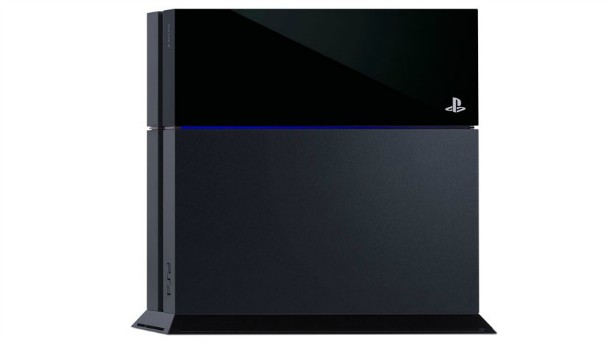
At this point, you’ve likely made up your mind about whether to take the next-gen plunge or wait it out. The PlayStation 4 launches on November 15, and with it comes a slew of new games, tech, and potential. If you’ve already decided to pick up Sony’s new console, you can use this list as a guide while you wait. Take a look at what games support digital upgrades, learn about its Vita support, and see what’s changing on the PlayStation Network. If you’re ready to get in on the fun, you can read this while you’re waiting in line at midnight – the PS4 preorder ship has long since sailed for most of us. Either way, here’s everything you need to know about the PlayStation 4.
The Console
The PlayStation 4 is a sleek-looking machine, built from matte and glossy black plastic (“Jet black,” according to Sony). It measures about 10.83” wide by 2.01” high and 12.01” long, weighing in at a little over 6 pounds. As with previous PlayStation consoles, the power supply is built into the case – you don’t have to worry about snaking a bulky power brick behind your desk or entertainment center.
Tech Specs
Here’s what’s under the PlayStation 4’s hood:
- CPU: single-chip custom processor, x86-64 AMD "Jaguar," 8 cores
- GPU: 1.84 TFLOPS, AMD next-generation Radeon-based graphics engine
- Memory: 8GB GDDR5
- 500GB 5400 RPM SATA II hard drive
- 6X Blu-Ray Drive, 8X DVD
- Two USB 3 ports and an auxiliary port for the PlayStation 4 camera
- Gigabit Ethernet port, 802.11 B/G/N built-in WiFi, and Bluetooth 2.1
- HDMI, Analog-AV, and digital optical outputs
What’s in the Box?
Here’s what you get for $399.99:
- A PlayStation 4 console
- A DualShock 4 wireless controller
- A micro-USB charging cable for the controller
- A mono headset
- A 60” power cable
- A 79” HDMI cable
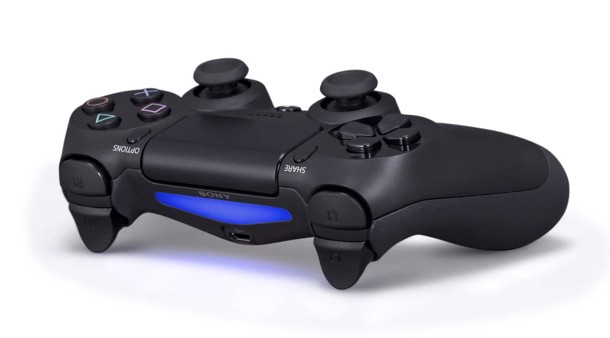
The Controller
The DualShock controller has steadily evolved since Sony debuted it in 1997, but the DualShock 4 includes some of the most noticeable revisions yet. They include the addition of a capacitive touchpad, redesigned analog sticks with a concave surface and raised ring, “share” and “options” buttons instead of “select” and “start”, more rounded edges overall, redesigned triggers, a light bar LED array, vibration, three-axis accelerometer, three-axis gyroscope, headphone jack, and a mini-B USB 2.0/3.0 input. The DualShock 4 doesn’t have the pressure-sensitive face buttons that previous DualShock controllers have supported. It can, however, be charged while the system is turned off after adjusting an option in the PS4’s energy settings. Read Matt Helgeson’s hands-on impressions about the controller for more information on the DualShock 4 and how it stacks up to other Sony controllers.
The Touchpad
The DualShock 4’s touchpad is a capacitive sensor with an input resolution of 1,920x900 pixels per inch. It supports drag and drop, swiping, and multitouch input. It’s also clickable like a button.
Accessories
The PlayStation Camera
The PlayStation Camera is an optional accessory that will be available at launch for $59.99. It features stereoscopic cameras that allow the device to interpret depth, and four microphones. The PS4 ships with Playroom software, which is a series of augmented reality-based minigames and other diversions. The PlayStation 4 can interpret voice commands, either via the PlayStation Camera’s mics or a headset.
Other Accessories
Sony has stated that PlayStation 3 accessories, including the Blu-Ray remote, controllers, steering wheels, fight sticks, and Bluetooth headsets will not be compatible with the PlayStation 4. Bluetooth headsets designed specifically for the PlayStation 4 will be coming , and we expect that third-party manufacturers will fill shelves with products very similar to what you can find for the PlayStation 3.
Read on for a look at the PS4's launch lineup
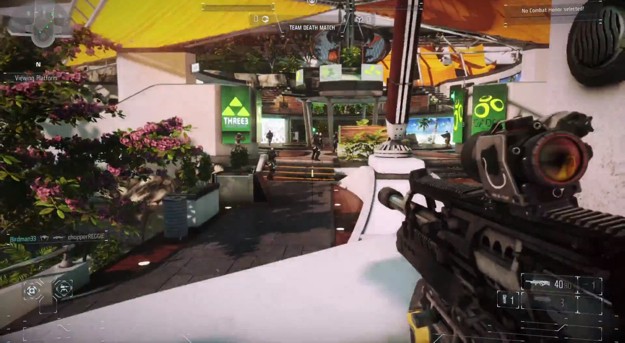
Games
Launch Games
Here are the games that should be available when the PS4 launches, either on store shelves or via download on the PlayStation Store.
First-Party Titles:
Third-Party Titles:
- Angry Birds Star Wars – Activision
- Assassin's Creed IV: Blag Flag – Ubisoft
- Battlefield 4 – Electronic Arts
- Call of Duty: Ghosts – Activision
- DC Universe Online - Sony Online Entertainment
- FIFA 14 – EA Sports
- Injustice: Gods Among Us Ultimate Edition – Warner Bros. Interactive
- Just Dance 2014 – Ubisoft
- Lego Marvel Super Heroes – Warner Bros. Interactive
- Madden NFL 25 – EA
- NBA 2K14 – 2K Sports
- Need for Speed: Rivals - EA
- Skylanders: Swap Force - Activision
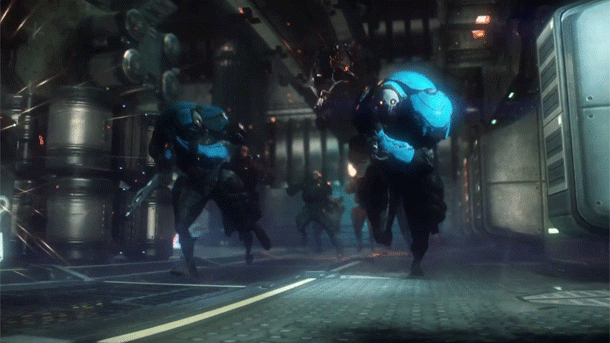
Indie Titles:
- Contrast – Compulsion Games
- Trine 2 – Frozenbyte
- Super Motherload – XGen Studios
- Warframe – Digital Extremes (pictured above)
Preorders and Upgrades
Players who picked up a few select games on their PlayStation 3 consoles won’t have to shell out $60 to upgrade to their PlayStation 4 counterparts. These games are Assassin’s Creed IV: Black Flag, Call of Duty: Ghosts, and Battlefield 4. If you downloaded these games, the PS4 versions will show up in your store for $9.99. If you went the retail route, check your box. There should be a code that you can enter into the PS4 that will let you download the PS4 version for the same $9.99. You will have to keep the PS3 version of the disc in your PS4 to play it, however, as a means of authentication.
Players can also digitally preorder several games on the PlayStation Store, and each preorder includes a bonus or two. Killzone: Shadow Fall will come with The Shadow Pack, which includes the soundtrack, a skin for the in-game OWL drone, and a "multiplayer spotlight move." Call of Duty: Ghosts (in standard or hardened editions) comes with the Free Fall map. Assassin's Creed IV: Black Flag (in standard or gold edition) comes with an Aveline ship figurehead. Finally, Battlefield 4 comes with the China Rising expansion pack.
Storage Requirements
The PlayStation 4 includes a 500 GB hard drive, and it looks like it could fill up quickly. Installation-space requirements are starting to come out, and they’re going to put a dent in that storage space. Fortunately, Sony says players can swap out the default drive with any compatible 5400 RPM SATA II hard drive no thicker than 9.5 mm and with a minimum of 160 GB of space. The system doesn’t support external hard drives for game storage.
Here are three titles with their known storage requirements, which should provide a glimpse at the size of next-gen games.
- Call of Duty: Ghosts – 49 GB
- Killzone: Shadow Fall – 45 GB
- Knack – 37 GB
Backward Compatibility
While the PlayStation 3 sported backward compatibility with the PlayStation 1 and PlayStation 2 (early models only), Sony is stepping away from its past for the PlayStation 4. While you won’t be able to use your previous-generation discs or PSN games, Sony is planning to roll out a cloud-based gaming service in 2014.
Details are still slim on how this will work, what it will cost, and whether previously purchased PSN licenses will carry over. It does mean that games from the expansive PlayStation library from generations past will likely be available to stream to your PlayStation 4.
Keep reading for more information about changes to the PSN, how video streaming works, and more.
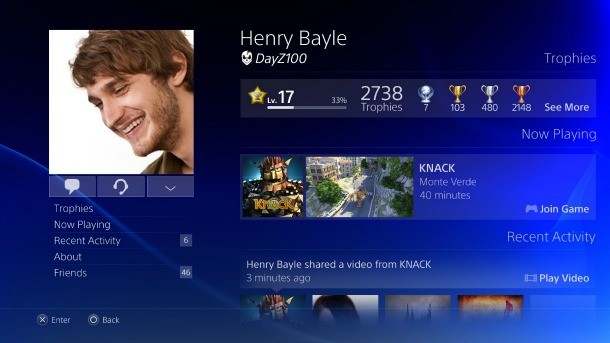
Changes to the PlayStation Network
One of the biggest changes to the PlayStation Network for the PS4 is the transition of multiplayer gaming to a paid service. PlayStation Plus membership is required. Annual membership is the least expensive way to purchase, and that will cost you $49.99 per year (three-month subscriptions are available for $17.99 each). Only one membership is required per system.
Free-to-play games and video services are still in front of the pay wall. You’ll be able to access those without PlayStation Plus.
PlayStation Plus Instant Game Collection will also carry over to the PlayStation 4. On November 15, when the console launches, members will have access to Housemarque’s Resogun and Compulsion Games’ Contrast. We expect that PlayStation 4 games will be available as part of the program monthly alongside PS3 and Vita titles.
The number of friends you’ll be able to have connected to your PlayStation ID (which is persistent from previous platforms) has been increased from 100 to 2,000. Users will have the option of sharing their real names with select friends or continue to use their PSN IDs.
PS3 players will not be able to voice chat with PS4 players, but text messages can be sent back and forth. It’s not yet clear how games like DC Universe Online will work. That title puts both platforms’ players in the same server.
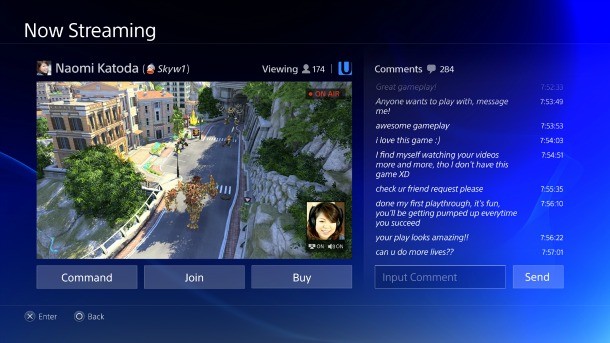
Video Sharing and Streaming
One of the big innovations Sony is including in the PlayStation 4 is gameplay sharing. This is handled with a press of a button on the Dual Shock 4 controller. The PlayStation 4 is constantly capturing approximately 15 minutes of gameplay video. This ensures that you’ll always be able to capture something cool that happens, even if you’re not actively recording when it happens.
PlayStation Plus is not required for video and screenshot sharing to Facebook or livestreams to Twitch or Ustream. Live video archiving will only be available on Twitch at launch (and must be pre-configured in the account settings via PC). You’ll be able to announce to Facebook and Twitter when you start streaming, so your friends can tune in.
YouTube will not be supported at launch, nor will external capture devices connected via the system’s HDMI port. Sony will be patching in support for those devices, though.
There is also no way to extract video saved to the PlayStation 4 hard drive via an external storage device. According to Sony, the ability to upload stored footage to Facebook will be coming in a post-launch update.
Remote Play
The PlayStation Vita can serve two functions for PlayStation 4 titles. For most games, the Vita can be used for off-television play (similar to the Wii U Gamepad). Sony says that most titles should be supported, provided they don’t require additional accessories like the PlayStation Camera.
Sony recommends that for best use, the PlayStation 4 should be connected via ethernet and the Vita should be close to the wireless access point. It’s not inconceivable that you’ll be able to use your Vita to play PS4 games away from home, but it doesn’t sound like that’s going to be the optimal scenario. The Vita will also support second-screen functions.
The handheld also supports cross-platform voice chat with the PlayStation 4 (something the PS3 does not offer). Upcoming second-screen will offer maps, stats, and other features included by developers to enhance the gaming experience.
Features Coming After Launch
When the PlayStation 4 was announced (and over the subsequent months) we learned about a number of enhancements that will be coming to the system. Unfortunately, not all of those will be available at launch.
Many core system functions will need to be activated via a 300 MB day-one patch. You’ll also be able to request a Blu-ray activation disc from Sony if you can’t connect to the internet.
Prior to this patch, you will not be able to play DVDs or Blu-ray movies, use Vita remote play and second screen features, record video or take screenshots, use voice commands or face recognition (PlayStation Camera), or use online multiplayer.
There are still a few features that we’ll be waiting for. You won’t be able to share your controller with a friend over PSN (a feature to call in help in tricky spots). The system also won’t have “suspend and resume” right away, this will eventually allow players to put the system into a sleep mode and pick up right where they left off.
Initially, Sony had suggested that MP3 and DLNA (media server) support wouldn’t be included as features for the PlayStation 4. After significant fan response, the company is reconsidering. The PlayStation 4 will not play CDs though, nor will it have a music visualizer.
If you’re using a legacy gaming headset that connects wirelessly or via USB, you’ll be waiting for a compatibility patch. This includes PlayStation-branded Pulse stereo headsets. Bluetooth chat headsets will not be supported at all.
Mike Futter contributed to this article

Get the Game Informer Print Edition!
Explore your favorite games in premium print format, delivered to your door.
- 10 issues per year
- Only $4.80 per issue
- Full digital magazine archive access
- Since 1991









